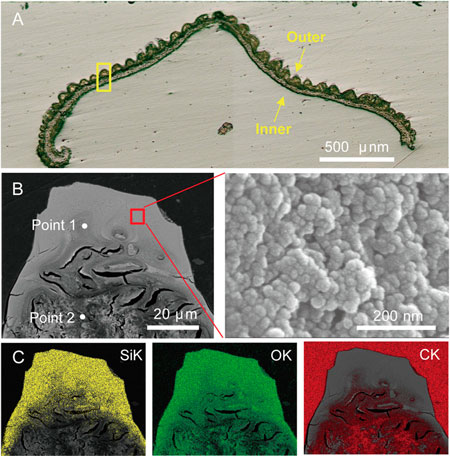| Posted: Jul 16, 2013 | |
Will future battery parts be grown on a rice field? |
|
| (Nanowerk Spotlight) The list of nanotechnology research that get inspired by nature gets longer and longer – whether it's to mimic natural structures (e.g. peacock feathers, butterfly wings, gecko feet, Lotus leaves) for nanoscale patterns and devices, or use naturally occurring nanoparticles instead of synthetic ones (read for instance: "Flesh-eating fungus produces cancer-fighting nanoparticles") for the fabrication of high-tech materials and products. | |
| Now, rice has made it onto this list. Researchers in Korea have found that rice husks – the outer, protective covering of a rice kernel – can be a source of silicon that can be used for high-capacity lithium battery anodes. | |
| Most of today's lithium-ion batteries rely on anodes made from graphite, a form of carbon. There are several candidate electrodes to replace graphite as the anode for lithium-ion batteries and silicon has been recognized as a favorable anode material because its capacity is 3-5 times larger than those of existing graphite anodes. | |
| However, so far the cycle life performance of silicon anodes has been challenging due to large volume expansions. The problem has been that previous silicon anode designs broke down from repeated swelling and shrinking during charging/discharging cycles and quickly became useless. | |
| The new work, reported in the July 8, 2013 online edition of PNAS ("Recycling rice husks for high-capacity lithium battery anodes"), demonstrates that rice husks, a major by-product in rice harvest, can be used to produce silicon with an ideal porous nanostructure for use in high-capacity lithium-ion battery (LIB) anodes. | |
 |
|
| (A) Optical microscope image of a rice husk. (B) (Left) Back-scattered electron (BSE) image of outer surface of a rice husk magnified from the yellow box in A. (Right) Field emission scanning electron microscope image of the outer rugged surface of a rice husk, indicating the silica body in the RH has a nanoporous structure. (C) (Left to Right) Energy-dispersive elemental mapping analyses of silicon, oxygen, and carbon, indicating that Si exists mainly along the outer surface. (© National Academy of Sciences of the United States of America) | |
| "The interconnected nanoporous structure of rice husks, developed in years of natural evolution for efficient cultivation of rice, can resolve important issues in silicon anode operation, enabling excellent cycling and power performance," Jang Wook Choi, an Associate Professor at the Korea Advanced Institute of Science and Technology (KAIST), who led the work, tells Nanowerk. "Given that annual global rice production reaches 700 hundred million tons, the promising battery data herein show how a part of the waste from rice husks – which reaches 20 wt% of the entire rice kernel – can be a massive resource to meet the ever-increasing demand for silicon in advanced batteries." | |
| One of the research areas of Choi's Energy Nanomaterials Group lies in bio-inspired materials for lithium-ion batteries. In a previous Nanowerk Spotlight, for instance, we reported on his work to develop a highly functional binder for lithium-ion batteries ("Unique mussel wet-adhesion improves lithium-ion battery performance"). | |
| In this new research, Choi's team found a naturally existing nanoporous structure in rice husks, with the pores the size of tens of nanometers. Various purification treatments of ordinary rice husks, which preserved the unique 3D porous structure, resulted in over 99% pure silica. A further thermic reduction then transferred the 3D porous structure of the rice husk silica to silicon. | |
| To evaluate the rice husk silicon as a LIB anode, the researchers prepared coin-type half-cells. | |
| "For this testing, we coated the rice husk silicon with carbon layers (3-10 nm) to compensate for the intrinsically low electronic conductivity of silicon as shown in previous studies," explains Choi. "We found that this carbon-coated rice husk silicon anode material shows excellent discharge capacity retention during cycling using the stable interconnected porous structure. Its cycling performance is clearly better than those of bare silicon nanoparticles and carbonized polydopamine-coated silicon nanoparticles." | |
| These results lead him to conclude that the nanoporous structure found in rice husks is more suitable for solving the volume expansion problem in LIBs than any other artificially developed nanostructure. In particular, most of the artificially developed nanostructures have an issue of irregular particle sizes, but the structure from rice husks holds very uniform particles and pores. | |
| As the silicon technology in the battery industry gets more mature, it could be possible that one of your next smartphones contains a part that grew on a rice field. | |
 By
Michael
Berger
– Michael is author of three books by the Royal Society of Chemistry:
Nano-Society: Pushing the Boundaries of Technology,
Nanotechnology: The Future is Tiny, and
Nanoengineering: The Skills and Tools Making Technology Invisible
Copyright ©
Nanowerk LLC
By
Michael
Berger
– Michael is author of three books by the Royal Society of Chemistry:
Nano-Society: Pushing the Boundaries of Technology,
Nanotechnology: The Future is Tiny, and
Nanoengineering: The Skills and Tools Making Technology Invisible
Copyright ©
Nanowerk LLC
|
|
|
Become a Spotlight guest author! Join our large and growing group of guest contributors. Have you just published a scientific paper or have other exciting developments to share with the nanotechnology community? Here is how to publish on nanowerk.com. |
|
